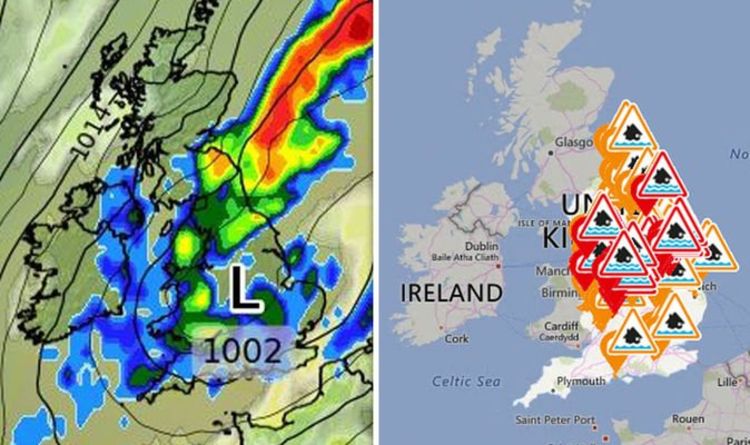Flood Alerts Explained: Understanding Flood Warnings And Staying Safe

Table of Contents
Understanding Different Flood Alert Levels
Flood alerts aren't all created equal. Different alert levels signify varying degrees of flood risk, requiring different responses. Knowing the distinctions between these alerts is vital for effective preparedness.
-
Flood Watch: A flood watch means that conditions are favorable for flooding. This isn't a cause for immediate panic, but it's a strong signal to begin preparing. Monitor weather reports closely, review your emergency plan, and ensure you have access to up-to-date information. Examples include heavy rainfall in a flood-prone area or a rapidly melting snowpack.
-
Flood Warning: A flood warning is serious. Flooding is either happening or is expected to happen imminently. This is the time to take immediate action. This could involve evacuating your home if instructed by authorities, moving valuable belongings to higher ground, and securing your property. A river exceeding its flood stage or a dam breach would typically trigger a flood warning.
-
Flood Advisory: A flood advisory indicates that minor flooding is occurring or is expected. While the threat is less severe than a warning, it still presents potential hazards. Be aware of your surroundings, avoid flooded areas, and stay updated on the situation. This could be caused by localized heavy rainfall leading to street flooding or ponding of water.
These alerts are typically issued by the National Weather Service (NWS) and local authorities. It's crucial to monitor these sources for relevant information in your area.
How to Receive Flood Alerts
Receiving timely flood alerts is paramount. Multiple methods ensure you're informed even if one system fails.
-
NOAA Weather Radio: A NOAA Weather Radio with Specific Area Message Encoding (SAME) technology is an excellent primary source for severe weather alerts, including flood warnings. These radios broadcast continuous weather information and alerts directly from the NWS, ensuring you receive critical information even during power outages. You can purchase one at most electronics stores.
-
Weather Apps: Numerous reliable weather apps (like AccuWeather, The Weather Channel, and WeatherBug) provide customized alerts based on your location. Enable push notifications for severe weather and flood alerts for immediate updates.
-
Local News and Media: Local television, radio, and news websites are crucial sources of information during severe weather events. They provide real-time updates, including evacuation orders and shelter information.
-
Emergency Alert Systems: Wireless Emergency Alerts (WEA) sent to your cell phone are a vital component of a multi-layered approach. Ensure that your phone's emergency alert settings are enabled to receive these critical notifications.
Using multiple methods is key; don't rely solely on a single source for flood alert information.
Creating a Flood Preparedness Plan
Proactive planning is the best defense against flood damage. Developing a comprehensive flood preparedness plan is essential for minimizing risks and protecting your family.
-
Identify Flood Risks: Assess your home's vulnerability to flooding. Are you located in a flood plain? What are the potential flood sources in your area (rivers, streams, storm drains)?
-
Develop an Evacuation Plan: Determine evacuation routes, designate a meeting place outside the flood zone, and identify a safe location for shelter.
-
Prepare an Emergency Kit: Stock a waterproof kit with essential supplies like water (at least one gallon per person per day), non-perishable food, flashlights, batteries, first-aid supplies, medications, important documents (copies), and extra clothing.
-
Elevate Valuables: Move valuable items, important documents, and electronics to higher levels in your home to protect them from floodwaters.
-
Community Flood Response: Understand your community's flood response plan, including evacuation routes and shelter locations.
Protecting Your Property During a Flood
During a flood warning, act swiftly and decisively.
-
Evacuate Immediately: If instructed to evacuate by authorities, do so without delay. Flooding can escalate rapidly.
-
Disconnect Electrical Appliances: Turn off power at the main breaker to prevent electrical hazards.
-
Move Valuables to Higher Ground: If you have time before evacuation, move valuables to upper floors or higher ground.
-
Never Drive or Walk Through Floodwaters: Floodwaters can be deceptively deep and fast-moving. They may contain hidden hazards, including debris, downed power lines, and contaminated water. Never attempt to drive or walk through them.
Conclusion
Understanding different levels of flood alerts, utilizing multiple alert systems, and preparing a comprehensive flood preparedness plan are all crucial steps for staying safe during flood events. Don't wait for a flood warning; be prepared. By taking these proactive measures, you significantly reduce the risks associated with flooding and protect your family and property. Take control of your safety with effective flood alert systems—sign up for alerts in your area today and create your personalized flood preparedness plan. Stay safe with timely flood alerts.

Featured Posts
-
 Jadwal Lengkap Siaran Langsung Moto Gp Argentina 2025 Trans7
May 26, 2025
Jadwal Lengkap Siaran Langsung Moto Gp Argentina 2025 Trans7
May 26, 2025 -
 Apples New I Phone Feature A Must Have For Formula 1 Fans
May 26, 2025
Apples New I Phone Feature A Must Have For Formula 1 Fans
May 26, 2025 -
 Choosing The Right Nike Running Shoes In 2025 Style Performance And Fit
May 26, 2025
Choosing The Right Nike Running Shoes In 2025 Style Performance And Fit
May 26, 2025 -
 Mercedes Faces Pressure To Extend George Russells Contract
May 26, 2025
Mercedes Faces Pressure To Extend George Russells Contract
May 26, 2025 -
 Turning Poop Into Profit How Ai Digests Repetitive Scatological Documents For Podcast Creation
May 26, 2025
Turning Poop Into Profit How Ai Digests Repetitive Scatological Documents For Podcast Creation
May 26, 2025
Latest Posts
-
 Roland Garros Djokovic Gauff And Andreeva Secure Opening Round Wins
May 30, 2025
Roland Garros Djokovic Gauff And Andreeva Secure Opening Round Wins
May 30, 2025 -
 Djokovics Powerful Roland Garros Start Gauff And Andreeva Victorious
May 30, 2025
Djokovics Powerful Roland Garros Start Gauff And Andreeva Victorious
May 30, 2025 -
 Djokovics Easy Win Norries Shock French Open Result
May 30, 2025
Djokovics Easy Win Norries Shock French Open Result
May 30, 2025 -
 Djokovic Dominates Roland Garros Debut Gauff And Andreeva Triumph
May 30, 2025
Djokovic Dominates Roland Garros Debut Gauff And Andreeva Triumph
May 30, 2025 -
 French Open Day 2 Norries Victory Djokovics Continued Dominance
May 30, 2025
French Open Day 2 Norries Victory Djokovics Continued Dominance
May 30, 2025
